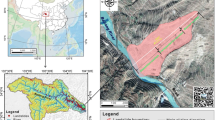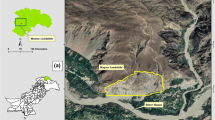Abstract
This paper presents the geometric and kinematic features of a landslide in Mabian, Sichuan, China, which occurred on 5 May 2018, derived from data of UAV photography. In combination with a field investigation, the UAV data permits to delineate the source area, overlap area, and accumulation area of this landslide. Coupled with DEM, its total source and accumulation volumes are estimated and the motion process is analyzed using the video record. The results show that Mabian landslide is a planar rocky downslope movement with a total horizontal projection area of 24,871 m2, source volume of 13,750 m3, accumulation volume of 213,200 m3, and the expansion rate of 55%. The sliding video demonstrates that the movement duration of the landsliding is about 16 s with a mean velocity 15.3 m/s, and the maximum velocity is 22.8 m/s. This study shows that the UAV-based aerial photography technology allow us to well characterize landslides rapidly in a quantitative manner.











Similar content being viewed by others
References
Chang-Chun LI, Zhang GS, Lei TJ, Gong AD (2011) Quick image-processing method of UAV without control points data in earthquake disaster area. Trans Nonferrous Metals Soc China 21(s3):s523–s528
Deng QD (2007) Chinese active tectonic map. Seismological Press, Beijing
Glenn NF, Streutker DR, Chadwick DJ, Thackray GD, Dorsch SJ (2006) Analysis of LiDAR-derived topographic information for characterizing and differentiating landslide morphology and activity. Geomorphology 73(1):131–148
Guzzetti F (2000) Landslide fatalities and the evaluation of landslide risk in Italy. Eng Geol 58(2):89–107
Harwin S, Lucieer A (2012) Assessing the accuracy of georeferenced point clouds produced via multi-view stereopsis from unmanned aerial vehicle (UAV) imagery. Remote Sens 4(6):1573–1599
Huang RQ (2009) Some catastrophic landslides since the twentieth century in the southwest of China. Landslides 6(1):69–81
Huang H, Long J, Lin H, Zhang L, Yi W, Lei B (2017) Unmanned aerial vehicle based remote sensing method for monitoring a steep mountainous slope in the Three Gorges Reservoir, China. Earth Sci Inf 10(3):1–15
Huang H, Song K, Yi W, Long J, Liu Q, Zhang G (2018) Use of multi-source remote sensing images to describe the sudden Shanshucao landslide in the Three Gorges Reservoir, China. Bull Eng Geol Environ 8:1–20
Jaboyedoff M, Oppikofer T, Abellán A, Derron MH, Loye A, Metzger R, Pedrazzini A (2012) Use of LIDAR in landslide investigations: a review. Nat Hazards 61(1):5–28
Kamps M, Bouten W, Arie CS, Kamps M, Bouten W, Arie CS (2017) LiDAR and orthophoto synergy to optimize object-based landscape change: analysis of an active landslide. Remote Sens 9(8):805
Lindner G, Schraml K, Mansberger R, Hübl J (2016) UAV monitoring and documentation of a large landslide. Applied Geomatics 8(1):1–11
Lombardi L, Nocentini M, Frodella W, Nolesini T, Bardi F, Intrieri E, Carlà T, Solari L, Dotta G, Ferrigno F, Casagli N (2017) The Calatabiano landslide (southern Italy): preliminary GB-InSAR monitoring data and remote 3D mapping. Landslides 14(2):685–696
Lucieer A, Jong SMD, Turner D (2014) Mapping landslide displacements using structure from motion (SfM) and image correlation of multi-temporal UAV photography. Prog Phys Geogr 38(1):97–116
Ma G, Hu X, Yin Y, Luo G, Pan Y (2018) Failure mechanisms and development of catastrophic rockslides triggered by precipitation and open-pit mining in Emei, Sichuan, China. Landslides:1–14
Martha TR, Kerle N, Jetten V, Westen CJV, Kumar KV (2010) Landslide volumetric analysis using Cartosat-1-derived DEMs. IEEE Geosci Remote Sens Lett 7(3):582–586
Mateos RM, Azañón JM, Roldán FJ, Notti D, Pérez-Peña V, Galve JP, Pérez-García JL, Colomo CM, Gómez-López JM, Montserrat O (2016) The combined use of PSInSAR and UAV photogrammetry techniques for the analysis of the kinematics of a coastal landslide affecting an urban area (SE Spain). Landslides 14(2):1–12
Niethammer U, James MR, Rothmund S, Travelletti J, Joswig M (2012) UAV-based remote sensing of the Super-Sauze landslide: evaluation and results. Eng Geol 128(11):2–11
Peternel T, Kumelj Š, Oštir K, Komac M (2017) Monitoring the Potoška planina landslide (NW Slovenia) using UAV photogrammetry and tachymetric measurements. Landslides 14(1):395–406
Prosdocimi M, Calligaro S, Sofia G, Dalla Fontana G, Tarolli P (2015) Bank erosion in agricultural drainage networks: new challenges from structure-from-motion photogrammetry for post-event analysis. Earth Surf Process Landf 40(14):1891–1906
Rossi G, Tanteri L, Tofani V, Vannocci P, Moretti S, Casagli N (2018) Multitemporal UAV surveys for landslide mapping and characterization. Landslides 2:1–8
Scheidegger AE (1973) On the prediction of the reach and velocity of catastrophic landslides. Rock Mech 5(4):231–236
Uysal M, Toprak AS, Polat N (2015) DEM generation with UAV photogrammetry and accuracy analysis in Sahitler hill. Measurement 73:539–543
Wei Z, Ramon A, He H, Gao W (2015) Accuracy analysis of terrain point cloud acquired by structure from motion using aerial photos. Seismol Geol 37(2):636–648 (In Chinese)
Xu C, Xu XW, Yao X, Dai FC (2014) Three (nearly) complete inventories of landslides triggered by the May 12, 2008 Wenchuan Mw 7.9 earthquake of China and their spatial distribution statistical analysis. Landslides 11(3):441–461
Ye X, Kaufmann H, Guo XF (2004) Landslide monitoring in the Three Gorges Area using D-INSAR and corner reflectors. Photogramm Eng Remote Sens 70(10):1167–1172
Yin YP (2001) A review and vision of geological hazards in China. Management Geological Science & Technology
Yin YP, Zheng WM, Liu YP, Zhang JL, Li XC (2010) Integration of GPS with InSAR to monitoring of the Jiaju landslide in Sichuan, China. Landslides 7(3):359–365
Funding
This work was supported by the National Key Research and Development Program of China (2017YFB0504104) and the National Natural Science Foundation of China (41661144037).
Author information
Authors and Affiliations
Corresponding author
Rights and permissions
About this article
Cite this article
Ma, S., Xu, C., Shao, X. et al. Geometric and kinematic features of a landslide in Mabian Sichuan, China, derived from UAV photography. Landslides 16, 373–381 (2019). https://doi.org/10.1007/s10346-018-1104-z
Received:
Accepted:
Published:
Issue Date:
DOI: https://doi.org/10.1007/s10346-018-1104-z




